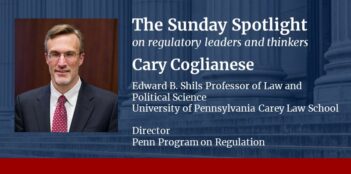
The pandemic offers the chance for the European Union to expand the scope of better regulation through innovation.
What is happening to the European Union’s (EU) better regulation agenda in light of the economic and social consequences of the global coronavirus pandemic?
Since December 2019, the current European Commission has been in office. A new Commission typically announces its vision for the better regulation strategy through a public communication. Although a better regulation public announcement was expected for spring 2020, this communication will likely materialize only after summer 2020 due to the coronavirus crisis. With Germany—a supporter of the “one-in-one-out” approach taken by current President of the Commission Ursula von der Leyen—ready to assume the EU presidency in the second half of 2020, the implementation of the one-in-one-out commitment will likely take center stage as far as better regulation is concerned.
Over the last five years, the Competitiveness Council has shown support for the one-in-one-out policy by launching a pilot project, among other initiatives. On February 27, 2020, the Council reaffirmed the pilot project, although it rightly offered the qualification that the one-in-one-out approach “should not lower social and ecological standards, nor be applied in a purely mechanical way.”
Other institutions within the EU are also involved in better regulation. The European Parliament and the Council of the EU are committed to bringing better regulation principles and tools into their activity through the Interinstitutional Agreement on better law-making.
The scene looks set for a rather modest ambition to carry on with the one-in-one-out plans formulated before the pandemic arrived in Europe—although the delay in the communication presents an opportunity for the EU to step up its better regulation efforts.
The new Fit for Future Platform (F4F)—a group of experts that will evaluate the effectiveness of current EU laws and offer recommendations for cost reduction and simplification—seems limited in its scope. F4F aims to simplify and reduce administrative costs of existing EU law. Although the platform has “future” in the title, it is set up to look at the past, rather than taking a forward-looking approach.
One-in-one-out and business impact targets are crude and ineffective policies. The notion of offsetting the costs of a new regulation with a reduction of administrative costs in another existing rule, possibly in the same sector, does not weigh benefits and other categories of costs, gives the false impression of comparing old and new rules that are not comparable in terms of net present values, and erodes the legitimacy of regulators.
The Commission has rejected regulatory targets twice—once in 2017 and once in 2019. Yet regulatory offsetting is popular across the Organization for Economic Cooperation and Development. It is certainly popular in Germany. Given that Germany will hold the EU presidency and that one-in-one-out is already a working method of the Commission, the implementation of one-in-one out under Germany’s leadership through the EU presidency will be fundamental. The Commission, however, will have to explain how to make this tool operational and how the perplexities of the previous Commission will be overcome.
Yet one-in-one-out is a narrow vision for an EU that needs innovation and green reconversion as its economies are experimenting with new technologies. Foresight is essential to the governance of innovation. On a positive note, in January, the President of the Commission extended the mandate of the Commission’s regulatory oversight body, the Regulatory Scrutiny Board (RSB), to include foresight. Arguably, the Commission did so to align the RSB to the competencies of the Vice President in charge of better regulation, Maroš Šefčovič. Vice President Šefčovič has a portfolio called “Inter-Institutional Relations and Foresight,” so it makes sense to highlight foresight in the mandate of the RSB.
This foresight dimension offers a potential means to widen the reach of better regulation into the domain of innovation. Hopefully, foresight will be integrated into the RSB’s scrutiny of the impact assessments. Such integration may be possible since the RSB recently amended its rules of procedure by including new provisions to improve the capacity of the institution to take on more ambitious tasks.
Indeed, better regulation has, conceptually at least, a central place in the context of the management of pandemic-related policies, which otherwise risk being dominated exclusively by macroeconomic and public health considerations. But this policy ought to be extended, relaunched, and recalibrated in terms of its instrumentation.
Last year, the Finnish presidency of the EU organized a conference on innovation, where some important connections between the calibration of regulatory policies and their effects of innovation were discussed in light of new instruments available to policymakers. This nexus between regulation and innovation—that is, regulation for innovation—is key to EU economies and societies, as we move from the acute crisis of stage one of the pandemic to a more nuanced “hammer and dance” strategy to cope with and ultimately defeat the virus.
The EU’s approach to regulation could play a pivotal role in the recovery stage. The governance of the gradual reopening of the EU economy and society requires a coordinated approach after the initial disjointed, national responses of European countries. The new approach must be respectful of the legal framework of the EU treaties and the lessons drawn from research on compliance, behavior, and the effects of regulation.
The key to success in this so-called stage two is to deploy social and economic innovations. There is no need to stimulate innovation, but the EU should cultivate innovation that is future-proof and in line with the vision of the EU in terms of sustainability through better regulation. Better regulation should be geared toward responsible innovation that is robust in relation to the EU values and priorities.
This summer—and possibly for the foreseeable future—we will need more automation and more digital payments in all 27 EU member states. We will also need more robust applications—such as electronic bracelets in connection with regulating beach activity—to allow us to enjoy a holiday abroad, neighborhood swimming pools, meals at restaurants, drive-in concerts, and other social activities.
Regulatory innovation may also help relieve some concern on the impact of access to justice and court outcomes, perhaps especially in the wake of the COVID-19 crisis. Recently, a member of Italy’s National Commission for Companies and the Stock Exchange lamented that civil justice is blocked. An acceleration in the use of artificial intelligence (AI) in this domain would alleviate the problem. AI has the potential for transparency and efficiency by changing the way in which court decisions are made. In civil and administrative matters, for example, algorithms are designed to learn from a vast set of data about the statistical correlations between cases and related decisions. AI technology is able to support decisions by improving predictability and consistency.
What are pro-innovation regulatory frameworks that are trustworthy, address compliance issues, strike a balance between regulation and alternatives to command and control (for example, self-diagnosis), and minimize administrative burdens? This is a question that can be addressed, thanks to the literature on regulation and accumulated experience, but first the nexus between regulation and innovation must become a priority issue on the agenda of EU institutions.
Related to this is the issue of how innovations, such as the technology of testing, tracing, and controlling the diffusion of the pandemic, can be governed in ways that are respectful of fundamental rights. The EU has been championing the right to privacy for many years with regulatory instruments such as the General Data Protection Regulation. In the United Kingdom, the Data Protection Impact Assessment has already generated controversies about its legal flaws in terms of how personal data are protected—something that will become a regulatory alignment issue with Brexit. We can expect more public attention to regulatory policy instruments, especially the Data Protection Impact Assessment and freedom of information acts, as countries handle trade-offs between transparency and innovation.
On top of these challenges, the pandemic has inspired the European Commission to push forward with its plans for a green deal. The crisis has shown that the way out of this pandemic necessitates a large, coordinated effort to reopen the single market gradually in the second half of 2020, and in the long term, to reconvert industry and the EU’s model of growth toward sustainability. Indeed, European cities are changing, with more bicycle paths introduced every week. Some companies have decided to carry on with remote working even when people can return to work. Universities have learned how to deliver parts of their curriculum online. The green deal is a vision that will be represented in a range of regulatory decisions which may either hinder or support innovations to reconvert industry. The efforts of the German presidency of the EU should go toward responsible regulation, bearing in mind priorities and values.
There is a demand for a stepwise change in better regulation policy. The toolbox and experience in the regulatory field provide rich lessons. The necessity to accompany macroeconomic readjustment with regulatory policies in support of responsible innovation seems clear, and the scope of better regulation should be widened. This scope should address the regulatory balancing acts in transparent, evidence-informed ways and in the context of pluralism.
But the big question is whether the EU will be able to rise to this challenge or will prefer a low-key, narrow better regulation vision based on administrative burdens and the one-in-one-out policy. Will the EU’s institutions—that is, the Commission, European Parliament, and the Council of the EU—carry on with business as usual? There is a window of opportunity for a paradigmatic change. EU institutions should learn quickly and seize this opportunity.
The author’s research on regulatory policy instruments has been funded by Protego, Procedural Tools for Effective Governance, Advanced European Research Council (ERC) Project number 694632.
The author wishes to express his gratitude to Larissa Morgan for her editorial assistance—with the usual caveat that errors and omissions are exclusively his own.




